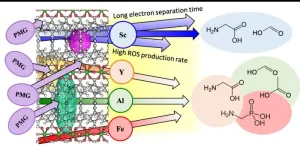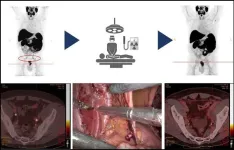(Press-News.org) Even people whose physical activity levels fall short of recommended guidelines, but who manage to do some during their leisure time, are likely to have a lower risk of stroke than their sedentary peers, suggests a pooled data analysis of the available evidence, published online in the Journal of Neurology Neurosurgery & Psychiatry.
The effects are independent of age and sex, the findings show, prompting the authors to suggest that everyone should be encouraged to do whatever level of physical activity they can manage in their leisure time.
There’s no doubt that moderate to high levels of leisure-time physical activity curb stroke risk. But it’s not clear if even modest amounts confer protection, and if any such effects depend on age and sex, explain the authors.
While international guidelines recommend 150 minutes or more a week of moderate intensity physical activity or 75 minutes or more of vigorous intensity activity to lower the risk of cardiovascular disease, including stroke, not many adults achieve this, say the researchers.
To find out if lower levels of physical activity might still confer protection, the authors trawled research databases for relevant studies. They pooled the results of 15, involving 752,050 adults whose health had been monitored for an average of 10.5 years.
Each study assessed the potential impact of between 3—none, below target, and ideal—and 5—none, insufficient, low, moderate and intense— levels of leisure time physical activity on stroke risk.
The pooled data analysis of 5 studies assessing 3 levels of leisure time physical activity showed that, compared with no physical activity, the highest ‘ideal’ amount cut the risk of stroke by 29%, but that some ‘below target’ activity still reduced the risk by 18%.
Similar findings emerged for the pooled data analysis of the six studies reporting on 4, and the two reporting on 5 levels of leisure time physical activity. Compared with none, a moderate level of physical activity cut the risk of stroke by between 27% and 29%.
These effects were independent of sex and age, the analysis showed.
The authors acknowledge several limitations to their findings, chief among which were the variable definitions of different levels of activity used in the included studies and the reliance on subjectively assessed levels of physical activity.
Nevertheless, the authors conclude that recreational physical activity, even in small amounts could help ward off stroke in the long term.
“According to our results, all levels of [leisure time physical activity] can be beneficial for stroke prevention, including levels currently regarded as low or insufficient,” they write. “People should be encouraged to be physically active even at the lowest levels.”
END
Even low levels of leisure time physical activity help to lower stroke risk
Effects independent of age and sex, pooled data analysis shows
2024-03-06
ELSE PRESS RELEASES FROM THIS DATE:
Daily step count of 9,000 to 10,000 may counteract risk of death and cardiovascular disease in highly sedentary people
2024-03-06
In good news for office workers, a new study from the University of Sydney’s Charles Perkins Centre (Australia) has found increasing your step count may counteract the health consequences of too much sedentary time each day.
The study of over 72,000 people, published in the British Journal of Sports Medicine, found every additional step up to around 10,000 steps a day was linked to reduced risk of death (39 percent) and cardiovascular disease (21 percent) regardless of how much remaining time was spent sedentary.
Previous studies have shown an association between greater daily step count and lower levels ...
Novel device for stomach complaints has successful human trial
2024-03-06
The endoscopic mapping device, developed over more than a decade by scientists at the Auckland Bioengineering Institute, consists of an inflatable sphere covered in sensors, delivered down the oesophagus and able to measure electrical activity in the gut.
In the same way abnormal heart electrical signals can cause serious heart problems, so research has found faulty bioelectric gut waves can lead to stomach pain, nausea, vomiting and bloating.
But often doctors can’t find out what the problem is. ...
Oregon State researchers make key advance toward removing pesticide from groundwater
2024-03-06
CORVALLIS, Ore. – Scientists led by an Oregon State University chemistry researcher are closing in on a new tool for tackling the global problem of weedkiller-tainted groundwater.
Kyriakos Stylianou of the OSU College of Science led an international team that identified a material known as a metal-organic framework, or MOF, that showed an ability to completely remove, and also break down, the oft-used herbicide glyphosate.
The MOF, one of four tested in a collaboration among scientists from Oregon State and Tiangong University in China, is based on scandium, chemical symbol Sc, ...
UTEP clinical trial to encourage healthy walking habits
2024-03-06
EL PASO, Texas (March 5, 2024) – Health researchers at The University of Texas at El Paso are launching a clinical trial to improve walking in the El Paso community, thanks to a $4.4 million grant from the National Institutes of Health (NIH). The project will enroll local school district employees in 50K 4 Life, a program that challenges them to improve their health by walking at least 50,000 steps per week.
“This is an exciting opportunity to improve our community’s health through the simple, free and life-changing ...
Research explores the cooling effects of ‘scuba-diving’ in lizards
2024-03-06
BINGHAMTON, N.Y. -- Anoles are the scuba-diving champions of the lizard world, able to stay underwater for more than 16 minutes. For animals whose body temperature depends on the environment, time spent in a cool running stream can have some tradeoffs, according to new research from Binghamton University, State University of New York.
A recent study by Binghamton University doctoral candidate Alexandra M. Martin, Christopher K. Boccia of Queens University in Canada, and Binghamton University Assistant Research Professor of Biological Sciences Lindsey ...
Gender gap on Wikipedia
2024-03-05
Since it was created in 2001, Wikipedia has become a key element of the modern public sphere, which has revolutionized the way we create and share information. However, it has defects when it comes to its decentralization and flexibility, specially regarding inclusion and diversity.
Some gender biases that stand out are shown in its content and its editorial participation. It has a low percentage of women’s biographies and an unequal representation in editing. Also, there are gaps in the gender representation regarding its content, biases in editing and participation, as well as imbalances in readership.
These ...
Scientists to study real-world eating behaviors using wearable sensors and artificial intelligence
2024-03-05
A pedometer measures your steps, but what if you had a similar automated device to measure your eating behavior? Evidence from nutritional studies has long shown that the speed, timing and duration of an individual’s eating behavior are strongly related to obesity and other health issues. While eating behaviors can be accurately measured in a controlled laboratory setting, a blind spot exists when researchers attempt to study how participants actually eat “in the wild.”
A new National Institutes ...
Radioguided surgery accurately detects and removes metastatic lymph nodes in newly diagnosed prostate cancer patients
2024-03-05
Reston, VA — Radioguided surgery can detect and remove metastatic pelvic lymph nodes in patients newly diagnosed with prostate cancer, according to research published in the March issue of The Journal of Nuclear Medicine. Targeting the prostate-specific membrane antigen (PSMA), which is overexpressed in most prostate cancer patients, radioguided surgery can improve nodal staging to guide treatment recommendations for this important patient population.
In newly diagnosed prostate cancer patients, nodal involvement correlates with recurrence, and determining if lymph node metastases are present and where they ...
Aluminum nanoparticles make tunable green catalysts
2024-03-05
HOUSTON – (March 5, 2024) – Catalysts unlock pathways for chemical reactions to unfold at faster and more efficient rates, and the development of new catalytic technologies is a critical part of the green energy transition.
The Rice University lab of nanotechnology pioneer Naomi Halas has uncovered a transformative approach to harnessing the catalytic power of aluminum nanoparticles by annealing them in various gas atmospheres at high temperatures.
According to a study published in the Proceedings of the National Academy of Sciences, Rice ...
Electrolyte cation types control electrochemical reactions on an electrode surface
2024-03-05
1. An international research group consisting of NIMS and the Finnish University of Jyväskylä has discovered through its electrode-electrolyte system research that electron and proton (i.e., hydrogen ion) transfer mechanisms during oxygen reduction reactions (ORRs) on electrode surfaces vary depending on the types of cations dissolved in the electrolytic solution. These results suggest that the energy conversion efficiencies and selectivity of electrochemical systems (e.g., fuel cells and water electrolysis hydrogen production systems) can be improved by selecting optimal reaction pathways and that this could be achieved without using expensive electrode ...
LAST 30 PRESS RELEASES:
Mount Sinai Health system receives $8.5 million NIH grant renewal to advance research on long-term outcomes in children with congenital heart disease
Researchers develop treatment for advanced prostate cancer that could eliminate severe side effects
Keck Medicine of USC names Christian Pass chief financial officer
Inflatable fabric robotic arm picks apples
MD Anderson and SOPHiA GENETICS announce strategic collaboration to accelerate AI-driven precision oncology
Oil residues can travel over 5,000 miles on ocean debris, study finds
Korea University researchers discover that cholesterol-lowering drug can overcome chemotherapy resistance in triple-negative breast cancer
Ushikuvirus: A newly discovered giant virus may offer clues to the origin of life
Boosting the cell’s own cleanup
Movement matters: Light activity led to better survival in diabetes, heart, kidney disease
Method developed to identify best treatment combinations for glioblastoma based on unique cellular targets
Self-guided behavioral app helps children with epilepsy sleep earlier
Higher consumption of food preservatives is associated with an increased risk of type 2 diabetes
NTU Singapore-led team captures first-ever ‘twitch’ of the eye’s night-vision cells as they detect light, paving the way for earlier detection of blindness-causing diseases
Global aviation emissions could be halved through maximising efficiency gains, new study shows
Fewer layovers, better-connected airports, more firm growth
Exposure to natural light improves metabolic health
As we age, immune cells protect the spinal cord
New expert guidance urges caution before surgery for patients with treatment-resistant constipation
Solar hydrogen can now be produced efficiently without the scarce metal platinum
Sleeping in on weekends may help boost teens’ mental health
Study: Teens use cellphones for an hour a day at school
After more than two years of war, Palestinian children are hungry, denied education and “like the living dead”
The untold story of life with Prader-Willi syndrome - according to the siblings who live it
How the parasite that ‘gave up sex’ found more hosts – and why its victory won’t last
When is it time to jump? The boiling frog problem of AI use in physics education
Twitter data reveals partisan divide in understanding why pollen season's getting worse
AI is quick but risky for updating old software
Revolutionizing biosecurity: new multi-omics framework to transform invasive species management
From ancient herb to modern medicine: new review unveils the multi-targeted healing potential of Borago officinalis
[Press-News.org] Even low levels of leisure time physical activity help to lower stroke riskEffects independent of age and sex, pooled data analysis shows






